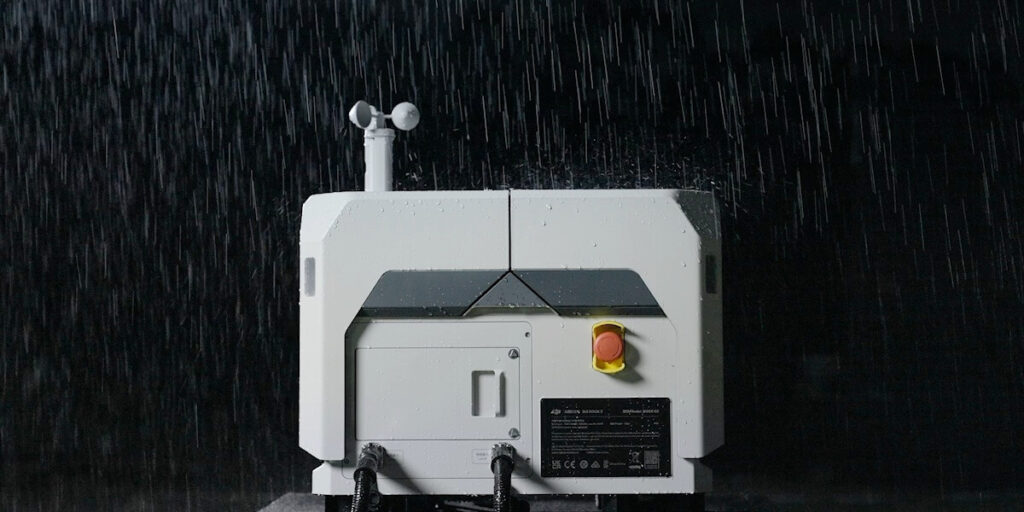
Although drone docking technology originated in the late 1960s, it has evolved significantly over time and is now attracting considerable attention in various fields and
in industries. From agricultural mapping and infrastructure inspections to emergency response and security monitoring.
This solution offers fully automated and rapidly deployable technology.
How does a drone docking system work?
Drone docking technology has made a significant breakthrough in autonomous UAV (unmanned aerial vehicle) operations. This includes a system where drones are stored, charged and launched back to execute commands. Such a self-contained and often portable device, commonly referred to as a “station” or “dock,” acts as the drone’s automated base and refueling station. Compared to conventional drones, drone docking stations require minimal human intervention.
Industry applications
Automated docking stations are used in various industries due to their wide range of capabilities. Here are some areas where this technology has already proven itself:
✓ Surveying and mapping: optimizes land and resource management by using and providing detailed images and data from both aerial and ground perspectives, enabling more accurate measurements and real-time monitoring of changes.
✓ Public Safety: Enhances emergency response strategies by enabling rapid deployment of drones for search and rescue operations, incident scene analysis, and disaster management.
✓ Infrastructure Maintenance: Facilitates inspections of critical infrastructure such as bridges, power lines and wind turbines. Automated and continuous
inspections help detect problems before they escalate, reducing downtime and maintenance costs.
Drone docking stations can operate autonomously 24/7, automating tasks, improving efficiency and safety in various industries.
Three main features of the DJI Dock 2:
- Cloud-based management: Integration with DJI FlightHub 2 offers cloud-based control that enables detailed mission planning, real-time monitoring and data management from anywhere, anytime.
- Fast charging option: Fast charging allows you to continue working with minimal interruptions. The M3D and M3TD drones charge wirelessly from 20% to 90% in just over half an hour, which is a remarkable charging speed for a mobile and compact device.
- Design for harsh weather: Dock 2 is designed to withstand the challenges of various weather conditions. It has an IP55 protection rating that provides protection against rain and dust, making it reliable and durable even in harsh environments.
Advantages of Dock 2
While the Dock 1 was a good option, the DJI Dock 2 is clearly superior. Below are its main advantages:
- Smaller size: Dock 2 is 75% smaller and weighs 68% less than its predecessor. Smaller size makes it easier to transport and install.
- Accurate mapping with RTK: DJI Dock 2’s compatibility with the Matrice 3D series allows you to achieve a new level of accuracy in data obtained from drones. It offers mapping capabilities that the Dock 1 could not provide. Continuous centimeter-level accuracy is possible thanks to the Dock 2’s integrated dual RTK module.
- Improved durability and performance: DJI Dock 2 is equipped with advanced sensors for improved situational awareness, a hybrid charging system and a weather-resistant housing (IP55 rating). These features reduce malfunctions and increase reliability during automated missions. Along with Dock 2, Matrice 3D offers a longer flight time (up to 50 minutes) and a larger operating range (up to 10 km), which allows you to work more efficiently mapping or viewing larger areas.
- Improved charging and battery efficiency: DJI Dock 2 takes slightly longer to charge drone batteries from 20% to 90% than Dock 1 (32 minutes
compared to 25 minutes). However, a 12V hybrid system offers several advantages, including extended battery life and reduced running costs. The Dock 2 ensures mission continuity with a built-in backup battery, allowing the drone to land safely during a power outage with an automatic “Return to Home” (RTH) function. - Reduced maintenance requirements: Dock 2 only requires maintenance twice a year, compared to the maintenance costs and potential downtime of Dock 1.
Dock 2 compatibility:
⁕ Matrix 3D: Matrix 3D is equipped with a zoom camera that provides high-impact detailed images and a wide-angle camera that produces quality photos.
These features make Matrice 3D ideal for surveying, land management, and other tasks that require accurate mapping data.
⁕ Matrice 3DT: Matrice 3DT offers a versatile camera system that combines wide-angle, telephoto and thermal cameras. This makes the Matrice 3DT an ideal tool for infrastructure inspection, search, rescue and public safety applications where both visual and thermal data are required.
DJI Dock 2 Station Price:
8,000 €
🔎 DJI Dock 2 docking station (Overseas Edition) – Droni.lv
If you have any additional questions about the product, feel free to ask, and you can also familiarize yourself with the product in our store.
🔎 Store : Zaubes 9A-39, Rīga, Latvija
For detailed information about Dock 2, you can find more information here –
🔎 DJI Dock 2 – DJI

